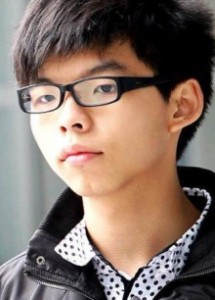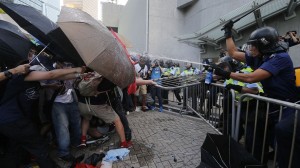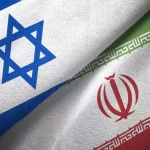Introduction
China is in the throes of a Color Revolution just as, if not more, menacing than the anti-establishment threat it faced in 1989 in Tiananmen Square. At that time, just as now, well-intentioned individuals (mostly youth) were caught up in the revolutionary romanticism of the day. Before it was the impending fall of communism throughout Eastern Europe, whereas nowadays it’s Color Revolutions, the ‘Arab Spring’ events (a theater-wide Color Revolution), and the Occupy Movement. Last time, however, the scene of activity was the capital, and the (unrealistic) goal was to bring about a quick and speedy end to Communist rule in China via a manipulated ‘people’s protest’. What is happening now, however, is more sinister in intent. The far-reaching strategic aim is to initiate a long-term spate of copy-cat protests not only in the other major urban areas of coastal China, but to serve as an inspiration for far more violent demonstrations in the distant and restive regions of Tibet and Xinjiang. Altogether, this has the disturbing and realistic possibility of descending into high-impact and crude ‘protester’-provoked violence and even all-out separatism in the periphery, running the risk of posing an existential threat to the very concept of ‘One China’.
The research is divided into two parts, with the first exploring the event and its external managers and financiers. Then it moves into focusing on the dupes and troops of the movement and the plotters’ own admission that it was pre-planned and they were trained in advance. This is followed by an examination into how the Color Revolution is being marketed and ends with the significant tactical innovation of the umbrella in purposely provoking a violent crackdown. The second section steps back from the situation’s specificities and investigates Hong Kong’s vulnerabilities to this destabilization, with the next portion looking at the Color Revolution’s overall theme and strategic aims, both domestically and internationally. Finally, an analysis of the government’s response to this threat concludes the article.
The ‘Umbrella Revolution’
The Hidden Hand of the ‘Umbrella Revolution’:
The ongoing events in Hong Kong exactly follow the template of all Color Revolutions. Well-intentioned individuals are being duped to join a movement aimed at overthrowing the authorities through a soft coup (for now). Legitimate grievances are being exploited by a revolutionary core and their cohorts to bring as many peaceful civilians into the fracas for use as human shields, in the hope that this will guarantee their own security amidst the crackdown that some of them are trying to provoke.
Importantly, this is not an entirely domestic protest movement, as investigative reporter and political analyst Tony Cartalucci has meticulously documented. His viral article proves the connection between the US State Department, its proxy National Endowment for Democracy, and the so-called ‘Umbrella Revolution’. As metaphorical icing on the cake, so to speak, to prove this point, Gene Sharp’s protégé and assistant, Jamila Raqtib, co-authored a recent article explaining why the ‘non-violent resistance strategies’ were utilized in the first place. One must keep in mind that Sharp is the godfather of ‘civilian’ anti-government activity all across the world, and that the majority of his works deal with how to topple the authorities in a targeted area. The ‘Umbrella Revolution’ should rightly be seen in this exact same light.
With this hidden hand in mind, one can more clearly understand how regular Hong Kong citizens with legitimate misgivings against their leaders can be corralled like cattle by the movement’s organizers into large-scale and strategically deployed ‘occupation ranches’. As unfortunate and grim as the comparison may seem, just like the rancher intends for his cattle to be destined for the slaughterhouse one day, so too does the Color Revolution ‘rancher’ intend for his ‘herd’ to feel the brunt of state force after their provocative ‘occupation’ threats, a motivation which will be described more in-depth in the second part.
The Dupes and Troops

As part of its destabilization operation, the US and its proxy partners have mobilized the use of Color Revolutionary ‘dupes and troops’. The student Scholarism movement is led by Joshua Wong, a Hong Kong teenager and already professional provocateur who has close and questionable relations with the US consulate in the territory. Under the auspices of being an ‘innocent teenager’, he has encouraged thousands of fellow Hong Kong students to join his movement, effectively duping all of those who participate. While in the beginning campaigning only to peacefully protest the controversial election law modifications, he now commands his group to consider a “final action” of occupying government buildings, in a sure fire move that will lead to a forcible state response. Gone is the rhetoric of protesting the law, the supposed original spark for the protests, and out comes the true motivations for the street actions – the overthrow (in their terms, ‘resignation’) of Hong Kong’s chief executive and other political members, effectively amounting to mob-inspired regime change. At this stage of rapid rhetorical escalation, it would not be surprising if some activists start endorsing outright secession for Hong Kong from the People’s Republic of China.
The thousands of dupes form the vast majority of the ‘Umbrella Revolution’s’ participants and provide a human shield and personal buffer against the core and cohort members organizing the subversive action. The larger and more organized group, however, is called Occupy Central with Peace and Love and run by Benny Tai. Their members admitted that they trained for months in order to prevent the police from dispersing them once they decided to initiate the destabilization. This makes the group more dangerous than Scholarism’s dupes, as they may have any level of militarized Color Revolution training, including the violent methods employed during EuroMaidan. Although originally planning their campaign to begin on 1 October, China’s symbolic national day (Color Revolutions are always associated with symbolism), they unexpectedly pushed it ahead a few days ostensibly to support Scholarism’s weekend activity. In reality, it was likely expected all along to push the original date forward in order to throw the Chinese authorities off, with Scholarism once more playing the dupe to Occupy Central’s troops, and Joshua Wong and his detainment being nothing more than a strawman justification for doing this.
Perception Management and ‘Selling Democracy’
The ‘Umbrella Revolution’ is being marketed in a very specific way to mask its regime change, destabilization, and secessionist end game. The slogan of ‘universal suffrage’ is highly misleading, as Hong Kong’s citizens were going to have a vote regardless, and nobody is being prevented from partaking in it. This is in stark contrast to Western governments that outright forbade Syrians living there from voting in the recent Presidential election back in June. In fact, in some of those Western countries, particularly the US, presidential and governor candidates only really get on the ballot due to the hefty financial backing that makes their campaign possible. One needs only to invoke the Electoral College system, where voters indirectly vote for the president, since it is their ‘electors’ who cast the actual ballots that matter.
Rhetorical hypocrisy aside, the ‘Umbrella Revolution’ is being marketed as a fresh student/youth movement versus the stale Communist Party bureaucracy. This isn’t true at all, as the majority of Hong Kong is against the subversives, which even CNN has implicitly acknowledged through their republication of an important op-ed piece by the Silent Majority founder. This group is the ‘anti-Maidan’ in Hong Kong, and already over 1.5 million Hong Kong citizens (out of 7 million) have signed a petition rejecting Occupy Central and its actions. This monumental number should be compared to the relatively paltry thousands that have taken to the streets to promote regime change to see which side true democracy rests on in Hong Kong.
In an intentional throwback to previous Western-sponsored destabilization efforts, a video has been making rounds where a young girl pleads with the Western audience to empathize with the protesters and support ‘democracy’. Called ‘Please Help Hong Kong’, it has already been recognized by online commentators as a structural copy of the ‘I am a Ukrainian’ video that was deployed during EuroMaidan, which itself was exposed as being linked to the NGO that managed the ‘Kony 2012’ and ‘Syrian Danny’ propaganda operations. Quite clearly, ‘Please Help Hong Kong’ is but another iteration of the same information manipulation formula that has been tried and tested in the destabilization operations before it.

The Umbrella as an Escalation Instrument
The eponymous Umbrella Revolution is known for the use of these accessories and plastic wrap to deflect pepper spray and other crowd control tools used by the authorities. The majority of the uninformed may laugh at the use of umbrellas or marvel at their ingenuity, but what most people neglect to realize is that this accessory is actually an instrument of violent and provocative escalation. By innovatively and inexpensively neutralizing the use of pepper spray and using plastic wrap to combat tear gas, the ‘protesters’ dangerously leave the outnumbered police with no other option than to use rubber bullets or worse to pacify the unruly masses, should need come to be. The Chinese authorities are now faced with two options – capitulate or escalate – but they have wisely created a third, unforeseen one, which is temporarily waiting it out. This risky decision will be discussed more at the conclusion of the work at the end of Part II.














Pingback: The ‘Umbrella Revolution’ and Secessionist Political Contagion in China (II) | Oriental Review
Pingback: La ‘rivoluzione degli ombrelli’ e il contagio secessionista in Cina | Aurora
Pingback: Hong Kong: gli studenti sfidano la Cina - Pagina 45
Pingback: La ‘rivoluzione degli ombrelli’ e il contagio secessionista in Cina – di Andrew Korybko |
Pingback: The US Is Juggling Chaos And Coordination In Order To Contain China | Oriental Review
Pingback: The US Is Juggling Chaos And Coordination In Order To Contain China | PushBack.US
Pingback: The US Is Juggling Chaos And Coordination In Order To Contain China | Friends of Syria
Pingback: The US Is Juggling Chaos And Coordination In Order To Contain China - Progressive Radio Network
Pingback: The US is juggling chaos and coordination in order to contain China | Free Ukraine Now
Pingback: ASEAN’s Geopolitical Arrangement Vis-à-vis The Chinese Containment Coalition | Oriental Review
Pingback: ASEAN’s Geopolitical Arrangement Vis-à-Vis The Chinese Containment Coalition | EMerging Equity
Pingback: Les USA jonglent entre chaos et coordination pour contenir la Chine | GLOBAL RELAY NETWORK
Pingback: Les USA jonglent entre chaos et coordination pour contenir la Chine | Arrêt sur Info
Pingback: Les USA jonglent entre chaos et coordination face à la Chine
Pingback: Les USA jonglent entre chaos et coordination pour contenir la Chine | Le Blog de la Résistance
Pingback: Les USA jonglent entre chaos et coordination pour contenir la Chine – Reveille toi
Pingback: Country of the Week: Hong Kong | Just Love Durham
Pingback: La Rivoluzione degli ombrelli – noicomunisti
Pingback: Hybrid Wars 7. How The US Could Manufacture A Mess In Myanmar (IV) | Oriental Review
Pingback: China’s Conundrum: What to Do About the “Young Marxists”? – Viralmount
Pingback: China’s Conundrum: What to Do About the “Young Marxists”? – Counter Information
Pingback: Hong Kong Unrest And Root Cause – OrientalReview.org – DE LA GRANDE VADROUILLE A LA LONGUE MARGE